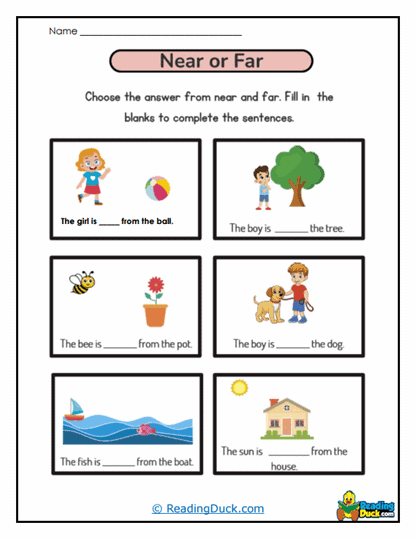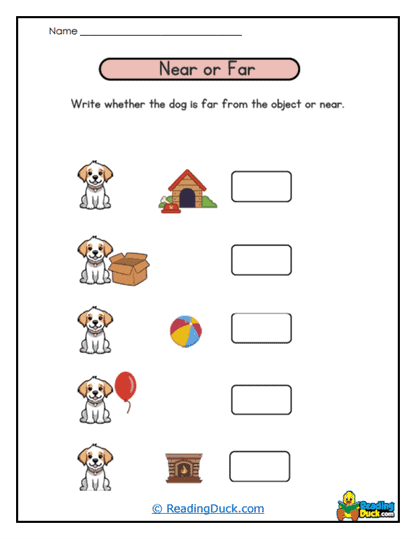Near or Far Worksheets
About Our Near or Far Worksheets
Our Near or Far worksheets are designed to help students understand and master spatial relationships using key position words. This collection falls under the Vocabulary category within the Skills section, specifically in the Position Words subcategory. The worksheets focus on the terms “near” and “far,” guiding students to recognize and describe objects and their positions in relation to one another. These essential skills contribute to a student's overall development in both communication and spatial reasoning, which are critical for many academic subjects and real-world tasks.
Each worksheet is presented in a downloadable PDF format, making them easy to view, print, and use in a variety of learning environments. The worksheets also come with an answer key, allowing teachers, parents, and tutors to assess progress quickly and accurately. Whether used in traditional classrooms, homeschooling environments, or for independent study, these worksheets offer an engaging and flexible resource for mastering the concepts of "near" and "far."
Understanding the Concept of Near and Far
Position words like near and far are fundamental tools that help students describe spatial relationships. Understanding where objects are in relation to one another is a key element of language development and spatial awareness. As students learn these concepts, they can better interpret their surroundings, follow directions, and communicate more effectively.
In a classroom setting, teachers typically introduce these concepts with relatable examples: "When something is near, it’s close to you, like the pencil on your desk. When something is far, it’s farther away, like the tree at the other end of the playground." Visualizing and practicing these terms helps students grasp how position words work in everyday contexts.
Examples of Using Near and Far in Sentences:
- "The dog is sitting near the fence."
- "The airplane is flying far above the clouds."
Our worksheets take these basic ideas and present them through structured activities, where students are tasked with identifying, comparing, and describing objects based on their spatial relationships. The worksheets include exercises like matching items that are near or far, circling objects in pictures, or drawing lines between objects that fit these descriptions. Since the worksheets are provided in an easy-to-use PDF format, teachers and parents can print them for instant access and use. Each worksheet includes an answer key for simple grading, which makes the learning process efficient and comprehensive.
Versatility for Different Educational Settings
One of the strengths of our Near or Far worksheets is their versatility, making them suitable for various educational settings. Whether you’re teaching in a traditional classroom, homeschooling, or offering tutoring or independent study, these worksheets are easily adaptable to fit different learning environments and teaching methods. The flexibility they provide ensures that they can be used in a variety of ways to enhance student learning.
Ways to Use the Worksheets in Various Settings:
- Group Activities: In a classroom setting, teachers can use the worksheets as part of group exercises, encouraging students to collaborate on identifying which objects are near or far. Working in groups allows students to discuss and reinforce their understanding through peer learning.
- Individual Assignments: The worksheets are perfect for independent practice, either during class or as homework assignments. Students can complete the exercises on their own, allowing them to reinforce their understanding of "near" and "far" at their own pace.
- Homeschooling: For homeschooling parents, these worksheets offer a structured, easy-to-follow way to introduce and practice the concept of spatial relationships. The worksheets can be integrated into daily lessons or used as supplementary material to support other educational activities.
- Enrichment or Remedial Tasks: Teachers can also use the worksheets for enrichment, providing advanced learners with more complex challenges related to spatial reasoning, or for remedial support, helping students who need additional practice.
The flexibility of the worksheets makes them a valuable tool for any learning environment. Whether used for group projects, individual tasks, or as extra practice, they can be seamlessly incorporated into various educational plans, offering a resource that meets the needs of diverse learners.
Supporting Early Language and Spatial Development
The concepts of near and far play a critical role in early language development and spatial awareness. Understanding these spatial relationships helps children describe their surroundings accurately, follow directions more effectively, and develop reasoning skills that support academic growth in subjects like math, science, and geography.
How These Worksheets Benefit Early Learners:
- Expanding Vocabulary: These worksheets help young learners expand their vocabulary by learning to use spatial terms like "near" and "far" correctly in different contexts. As students practice identifying these spatial relationships, they become better equipped to describe the world around them with greater accuracy and detail.
- Building Spatial Awareness: Recognizing whether something is near or far is essential for developing spatial awareness. These worksheets guide students through a series of exercises that strengthen their ability to interpret and understand the distance between objects, which is a foundational skill for more complex reasoning tasks later on.
- Interactive and Engaging: The visual and interactive elements of the worksheets keep students engaged. Activities like matching, drawing, and identifying help students actively participate in their learning, leading to greater retention and comprehension of the concepts of "near" and "far."
By focusing on early language and spatial development, these worksheets provide young learners with the tools they need to build strong foundational skills. The engaging format encourages interaction and critical thinking, helping students retain the knowledge they gain in an enjoyable and productive way.
Enhancing Learning for English Language Learners (ELL)
Our Near or Far worksheets are particularly beneficial for English Language Learners (ELL), as they provide clear visual examples and straightforward exercises that make it easier for students to grasp the vocabulary and concepts related to spatial relationships. By offering visual cues and practical activities, these worksheets help ELL students understand position words in real-world contexts, improving both their language proficiency and comprehension.
How These Worksheets Help ELL Students:
- Visual Support: Each worksheet includes images and diagrams that illustrate the concepts of "near" and "far." These visual aids help ELL students understand the vocabulary without relying solely on text, making it easier to grasp the meaning of the words.
- Simple Language: The instructions and exercises are written in simple, clear language, making them accessible for students at different levels of English proficiency. This ensures that ELL students can engage with the material without feeling overwhelmed by complex language.
- Practical Application: The worksheets focus on real-life examples and scenarios that students can relate to, such as identifying objects that are near or far in a classroom, home, or park. This practical application helps reinforce the vocabulary and allows students to apply the terms in meaningful ways.
By providing clear, easy-to-understand materials, these worksheets help ELL students improve their language skills while mastering important spatial vocabulary. The focus on real-world contexts ensures that students can confidently use the terms "near" and "far" in both academic and everyday situations.
Strategies for Teaching Near and Far
To ensure students fully grasp the concepts of "near" and "far," educators can incorporate a variety of teaching strategies that reinforce the learning process. By using these strategies, teachers can help students practice and apply the concepts in engaging, hands-on ways that encourage mastery of spatial relationships.
Effective Strategies for Teaching Near and Far:
- Use Real Objects: In the classroom or home, use physical objects to demonstrate the concepts of "near" and "far." For example, place a book near the teacher’s desk and another book far away, then ask students to describe their positions using the appropriate terms. This hands-on activity makes the concepts more tangible and easier to understand.
- Incorporate Movement: Encourage students to physically interact with their environment by moving objects or themselves. For instance, ask them to place a toy near their chair or move far from the teacher’s desk. This approach helps kinesthetic learners grasp the concepts through physical action.
- Daily Practice: Integrate the vocabulary into everyday routines. Teachers might ask students to line up near the door or sit far from the window, reinforcing the terms through repetition and daily use.
- Visual Storytelling: Use images or stories where characters or objects are positioned near or far from one another. Ask students to describe the positions, helping them practice the vocabulary in context while also developing their comprehension skills.
By incorporating these strategies into lessons, educators can create dynamic learning experiences that encourage students to master the terms "near" and "far" through both theory and practice. These strategies ensure that students build a strong understanding of spatial relationships, which they can apply across subjects and in real-world scenarios.
Conclusion
Our Near or Far worksheets offer an engaging, flexible resource for teaching students key position words related to spatial relationships. Whether used in traditional classrooms, homeschooling, or for independent study, these worksheets provide a valuable tool for helping students master the concepts of "near" and "far" while improving their vocabulary and spatial awareness.
With clear visual cues and practical exercises, these worksheets are especially beneficial for English Language Learners (ELL) and young learners building foundational language skills. Their flexibility makes them ideal for a wide range of educational settings, from group activities to independent assignments. By incorporating effective teaching strategies, educators can ensure that students not only understand the vocabulary but also feel confident using these terms in their daily lives.
Our Near or Far worksheets are an essential part of any educator’s toolkit, providing a structured, interactive approach to learning that supports both language development and spatial reasoning.









